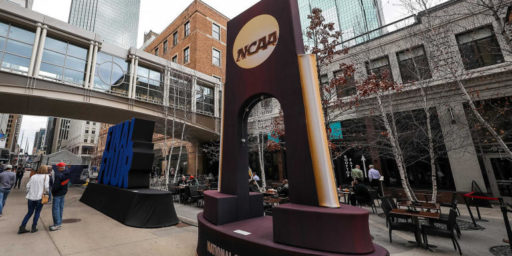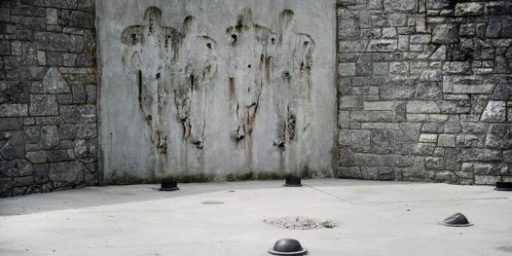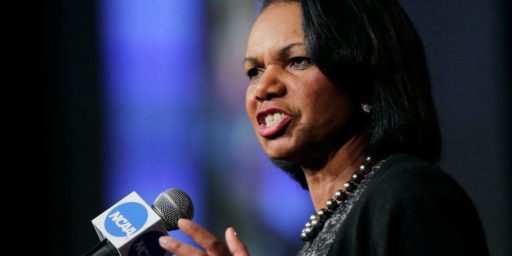NCAA Allows ‘Image and Likeness’ Compensation
Bowing to Immense political pressure to pay college athletes will dramatically change the game.

The governing body for major college athletics in the United States has reversed a fundamental principle of the system, allowing star athletes to get paid by outside sources. This will almost surely open the floodgates.
The Associated Press reports:
The NCAA took a major step Tuesday toward allowing college athletes to cash in on their fame, voting to permit them to “benefit from the use of their name, image and likeness.”
The nation’s largest governing body for college sports and its member schools now must figure out how to allow athletes to profit — something they have fought against doing for years — while still maintaining rules regarding amateurism. The NCAA Board of Governors, meeting at Emory University in Atlanta, directed each of the NCAA’s three divisions to create the necessary new rules immediately and have them in place no later than January 2021.
This move was inevitable, as there has been enormous political pressure on the NCAA to relax rules requiring star athletes to be “amateurs” while coaches rake in millions, schools tens of millions, and college sports as as a whole billions. But the very reason the NCAA was created in the first place, well over a century ago, is that schools and boosters were making a mockery of the process in order to win—and that was in an era where only pride was at stake.
In theory, I’m in favor of allowing star players to get paid. Football and basketball, in particular, have huge fan bases and generate massive revenues. It’s hard to argue that the athletes—disproportionately African-Americans from less-than-wealthy families—should get nothing until and unless they make it to the pros.
But, first, the NCAA has in recent years approved payments for the “total cost” of schooling, meaning that athletes are in fact given monthly stipends beyond tuition, room, board, and books. And they’re provided essentially unlimited meals. That’s not a bad deal—almost any other kid on campus would gladly take it.
But, second, the potential for abuse is high. In theory, only a handful of athletes are sufficiently famous that they’d make any money at all from endorsements and the like. But boosters would quickly figure out how to compete for recruits—even in non-revenue sports—by funneling “image and likeliness” money to them. The third-string offensive lineman from schools with richer alumni bases will suddenly be getting lucrative endorsement deals.
Relatedly, this further skews the recruiting playing field. Traditional powers with established coaches and massive budgets already have a huge advantage. And a single mega-booster, like a Phil Knight (Oregon) or a T. Boone Pickens (Oklahoma State) can really turn a program’s fortunes around. Think of what Oregon would be able to do if Knight could simply promise any athlete on the football or basketball team a $100,000—or, hell, a $1,000,000—endorsement deal? Or, how about USC and UCLA taking advantage of their Hollywood connections?
The NCAA is aware of these challenges, of course.
“One of the most distinctive things about college sports is this whole recruitment process,” NCAA President Mark Emmert told the AP. “The whole notion of trying to maintain as fair a playing field as you can is really central to all this. And using sponsorship arrangements, in one way or another, as recruiting inducements is something everybody is deeply concerned about.”
Ackerman and Smith said the challenges lie in determining what regulations need to be set in place; what markets athletes should be allowed to access; what entities and individuals they should be permitted to work with; and whether the schools themselves could provide funds to athletes through licensing deals.
But it’s unclear whether the NCAA even has the power to set parameters to rein in these potential abuses.
The NCAA’s move came a month after California passed a law that would make it illegal for NCAA schools to prohibit college athletes from making money on endorsements, autograph signings and social media advertising, among other activities.
“California has made it clear that we won’t accept any arbitrary limitations on college athletes’ right to their name, image, and likeness,” state Sen. Nancy Skinner, who co-sponsored the bill, posted in Twitter.
The California law goes into effect in 2023. More than a dozen states have followed with similar legislation, some of which could be on the books as soon as next year.
“This is another attempt by the NCAA at stalling on this issue,” said Ramogi Huma, executive director of the National College Players Association, an advocacy group.
The NCAA hasn’t done itself any favors by being so slow to make obvious concessions. While this was partly motivated by competitive fairness concerns as well as equity issues—can we pay athletes on revenue-producing teams like football but not pay those on costly programs like women’s lacrosse?—there was always the sense of hypocrisy in claiming “amateurism” while raking in hundreds of millions on television deals. And, yes, it’s particularly grating for schools to rake in money selling jerseys with a student-athlete’s name and number for $79 and giving the kid nothing in return. (Yes, they get the aforementioned scholarship-plus. But so does the kid whose jersey doesn’t sell.)
But critics undersell the potential for abuse:
It’s hard to say exactly how much athletes could fetch on an open market for their names. It could range from a few hundred dollars for creating personalized video and audio greetings for fans through companies such as Cameo, to thousands of dollars for doing television advertisements for local businesses.
This is assuming that the “free market” is based only on the value-added of using the student-athlete’s name and likeness. But, again, it’s inevitable that the value to a booster of getting the kid to play for their school’s team will also be a major factor. A five-star quarterback recruit may well generate a bidding war for his services.
Now, I suppose, one could argue that this is just the American Way. If someone is willing to pay that much to get a player on their team, why shouldn’t the player be able to benefit? That’s essentially what we do in other professional sports (although most have other strategies for promoting competitive balance, including salary caps and player drafts). But it would radically change the nature of college sports.






I graduated high school in north Florida in the mid-90s with a guy who went on to play almost a decade in the NFL. But between High School and the NFL was FSU. And this extraordinary athletically gifted person, from a literally dirt poor family, was driving a Lexus SUV months before he got to Bobby Bowden’s place.
To add another wrinkle, Sen Burr (NC) now wants to tax scholarships as income. My interest in sports has been waning in recent years. I think it is linked to the money involved.
https://thehill.com/homenews/senate/467993-burr-promises-bill-to-tax-scholarships-of-student-athletes-who-profit-off
@Teve:
In the late 80’s, and early 90’s, the Florida schools always had the best teams money could buy.
Miami, Florida, FSU.
@Teve: Yes, there are abuses. The NCAA has been quite ineffective at policing some abuses and is sometimes incredibly harsh over minor infractions. Still, given the enormous incentives involved, I think we’ve done a relatively decent job at keeping the worst excesses out.
@Scott: If we’re going to treat scholarship athletes as university employees, I guess it makes sense to tax their benefits. But the problem is that the overwhelming number, even in the revenue sports, are just getting by. It would be odd to tax my 20-year-old stepdaughter’s scholarship at Temple at a time when she’s making just a few bucks on the side from a paid internship. There’s real value in the scholarship, in that many of her cohort will leave school with massive debt. But it’s not exactly income, either, in that she can’t spend it, let alone cash part of it in to pay taxes on it.
I added the word I think you left out. College athletes have been paid by outside sources going at least as far back as the sainted John Wooden’s decision to ignore the favors Papa Sam Gilbert was doing for his players at UCLA. I don’t know if this change is a good thing or a bad thing, but at least it’s a little bit more of an honest thing.
If a student gets a music scholarship to school, they’re still allowed to get paid to play music outside of class.
If a student gets a science scholarship, they’re still allowed to get paid to work as a lab assistant outside of class.
If a student gets a tech scholarship, they’re allowed to get paid working as an intern or starting their own tech company outside of class.
But if we allow someone on an athletic scholarship to get paid for playing sports outside of class, apparently the world will end.
@Stormy Dragon:
The analogy just doesn’t work.
While I’m sure top schools compete for the best students for their music and STEM programs, there aren’t the same incentives tied to it. Schools don’t get 100,000 people a week to watch the orchestra or lab experiments; they do for football. Going back to the late 1800s, schools were cheating to win at football by bringing in “ringers” who weren’t even students. The NCAA’s predecessor organization was created to wring out those excesses and create a more level playing field.
@Roger: Again, I don’t deny that cheating still exists under the current rules. But schools do occasionally get hammered by the NCAA when they’re caught. I’m not four square against this change but I do think the impact on recruiting is likely to be way more than proponents acknowledge.
James, I think you are assuming facts not in evidence, i. e. that college sports are anything other than a corrupting malignancy on universities. I just don’t see it. I just don’t see why schools should have scholarship programs or endorsements or anything else. What exactly does this nonsense have to do with education or research?
What does make sense? Intramural sports that students do in their spare time. Separately, minor league basketball and football leagues acting as farm teams.
I’ve no strong feelings about the matter, but it seems fair for popular athletes to be paid for the use of their image and likeness, which is inalienably theirs.
@MarkedMan:
There’s quite a lot of research out there showing that a university winning a sport championship causes a bump for several years after in the quality of candidates applying, number and amount of research grants received, etc.
There’s no reason that winning at sports SHOULD improve any of those metrics, but humans are irrational, so they do anyways.
Just a detail: colleges can’t currently sell jerseys with a player’s name on them, though they undeniably push certain celebrity numbers every season.
@James Joyner:
I wonder how/whether the quality of STEM students in the postgraduate level affects the amounts of research grants a university gets.
Here’s a thought: get sports out of college. Stop wasting resources on absurdly overpaid coaches, stop spending millions on stadiums. The Europeans do it with clubs outside of school. Why don’t we?
Edit: I see @Marked Man beat me to it.
@MarkedMan:
and
@Michael Reynolds:
@Stormy Dragon answers it pretty well:
The bottom line: it’s an expensive but highly effective form of marketing.
Troy, where Steven Taylor and I began teaching together over 20 years ago (and where he’s now Dean), went from I-AA (now, FCS) to I-A (now, FBS) in like my second year there. We both thought it was just bizarre for a small teaching school that mostly recruited from the local area. The required average attendance for football was more than the entire population of the county in which the school resided. Yet, it worked exactly as planned: it vastly increased the university’s exposure and more than paid for itself.
Alabama, where I earned my PhD in 1995, has radically increased the size of its student population while simultaneously considerably raising its admission standards in the decade since they hired Nick Saban as football coach. Those five national championships have been worth way, way more than his paltry $10 million annual salary.
And that’s before we even factor in alumni loyalty. Even elite academic schools who aren’t competitive for national championships in revenue sports—the Ivy League and the service academies both come to mind—have rabid fan bases. Sports contribute to an esprit de corps that academics alone won’t create. I certainly own more Alabama clothing as a result of football than I would simply because of grad school.
@James Joyner:
Yet somehow schools with no sports or with notoriously weak teams still seem to do just fine. NYU has no football and effectively no sports. Cal States Fullerton, Northridge and Long Beach, ditto. Do you really think Harvard and Stanford and Yale would have a hard time attracting students minus a sports program?
And have we seen a study that weighs costs vs. benefits from college sports? Would such a study include the bullying, rape and all-around corruption that follow college athletics? How about the land use? What would you guess would be the real estate value of the land Stanford wastes on athletics in a part of California where a garage costs a million dollars?
@James Joyner:
I’m not even sure it’s marketing in the traditional sense so much as “anchoring bias”.
If you have people rate things according to characteristic A, and then characteristic B, the things that did well in the A-ranking will do better in the B-ranking than they would have if you had done that alone. Likewise things that did badly in the A-ranking will do worse in the B-ranking than they would have if you had done that alone. This happens even if A and B have nothing to do with each other.
So when everyone keeps hearing how good the University of Alabama is at football, they subconsciously start thinking the University of Alabama is better at, say, training surgeons then they otherwise would have.
@Stormy Dragon: As may be. But Harvard, MIT, Yale, etc show that excellence doesn’t require shackling yourself to a sham program